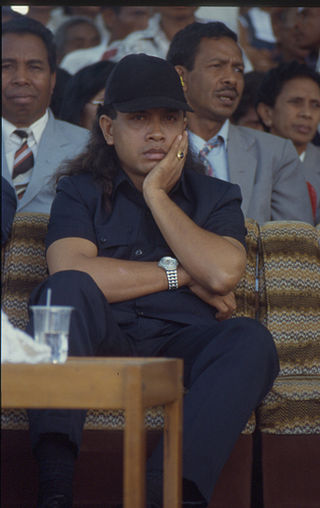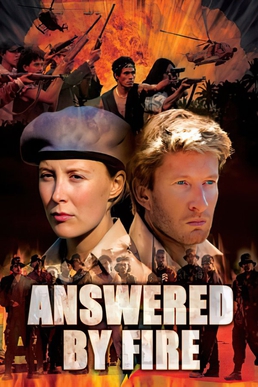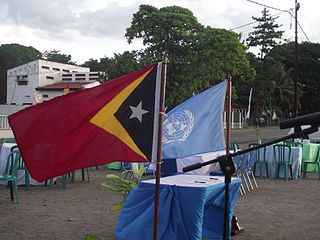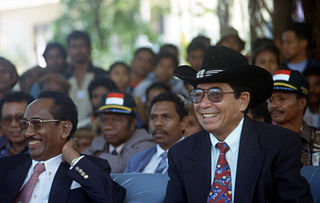
East Timor, officially the Democratic Republic of Timor-Leste, is a country in Southeast Asia and Oceania. The country comprises the eastern half of the island of Timor and the nearby islands of Atauro and Jaco. The first inhabitants are thought to be descendant of Australoid and Melanesian peoples. The Portuguese began to trade with Timor by the early 16th century and colonised it throughout the mid-century. Skirmishing with the Dutch in the region eventually resulted in an 1859 treaty for which Portugal ceded the western half of the island. Imperial Japan occupied East Timor during World War II, but Portugal resumed colonial authority after the Japanese surrender.

Eurico Barros Gomes Guterres is a pro-Indonesian, anti-Timorese independence militiaman recruited by the Indonesian military during East Timor's bid for independence between 1999 and 2000. He was involved in several massacres in East Timor, and was a chief militia leader during the post-independence massacres and destruction of the capital Dili.

Liquiçá is one of the municipalities of East Timor. Its capital is also called Liquiçá.
The Liquiçá Church massacre was a mass-killing that occurred in April 1999, during East Timor's bid for independence. It was the first case to be heard by the Second Special Panel.

Besi Merah Putih, meaning 'red and white iron' in Indonesian, was the official name of an East Timor, approximately 200-strong, pro-Indonesia militia (Wanra). It operated in Maubara, in the district of Liquiçá, and in the neighbourhood of the river Lóis, west of the capital Dili, under the leadership of Manuel de Sousa and with the support of Leoneto Martins, the district administrator (Bupati) of Liquiçá. It was founded on 27 December 1998 in Cai-Cassa, East Timor. The Indonesian ex-general Prabowo had direct links to Besi Merah Putih and trained members at a Kopassus base near Bogor in West Java. Tomé Diogo is also rumoured to have direct links to the BMP. The Indonesian army member is said to have led the militia directly.

Aitarak was the name of one of the most feared pro-Indonesia militia groups in East Timor during the late 1990s. On April 17, 1999, the group conducted 12 murders at the Manuel Carrascalão House massacre in Dili. That same month members took part in the Liquiçá Church massacre. At its height, the group was led by Eurico Guterres.

Manuel Guterres Viegas Carrascalão was an Indonesian parliamentarian and prominent East Timorese independence leader. The Carrascalão family is of mestiço ancestry;

Liquiçá is a coastal city in East Timor, 32 km to the west of Dili, the national capital. Liquiçá is the capital of Liquiçá District. The city has a population of 5,005 inhabitants.
Laksaur was one of the pro-Indonesia militias which committed atrocities around the time of the referendum for independence in 1999 in East Timor. They are considered the principal agents in the Suai Church Massacre, which occurred a week after the referendum. They were believed to have been supported by the military of Indonesia.

Answered by Fire is a two-part television film based on the 1999 conflicts in East Timor that led to its independence in 2002. The film is based on "Dancing with the Devil: A Personal Account of Policing the East Timor Vote for Independence", which was written by David Savage, an Australian Federal Police Officer who was based in Maliana during the vote and where the fictional "Nunura" is based, who returned to East Timor to lead investigations into the crimes against humanity committed there. The book is published by Monash University Asia Institute, Melbourne David Savage was a technical and script consultant during the filming and also played a minor role.

José Abílio Osório Soares was an Indonesian politician. He was the last governor of the Indonesian province of East Timor before the country's independence.

The Indonesian occupation of East Timor began in December 1975 and lasted until October 1999. After centuries of Portuguese colonial rule in East Timor, the 1974 Carnation Revolution in Portugal led to the decolonisation of its former colonies, creating instability in East Timor and leaving its future uncertain. After a small-scale civil war, the pro-independence Fretilin declared victory in the capital city of Dili and declared an independent East Timor on 28 November 1975.

The Santa Cruz massacre was the murder of at least 250 East Timorese pro-independence demonstrators in the Santa Cruz cemetery in the capital, Dili, on 12 November 1991, during the Indonesian occupation of East Timor and is part of the East Timor genocide.

The Indonesia–Timor Leste Commission on Truth and Friendship was a truth commission established jointly by the governments of Indonesia and East Timor in August 2005. The commission was officially created to investigate acts of violence that occurred around the independence referendum held in East Timor in 1999 and sought to find the "conclusive truth" behind the events. After holding private hearings and document reviews, the commission handed in the final report on July 15, 2008 to the presidents of both nations, and was fully endorsed by Indonesian President Susilo Bambang Yudhoyono, providing the first acknowledgement by the government of Indonesia of the human rights violations committed by state institutions in Timor. The commission is notable for being the first modern truth commission to be bilateral.
Australia, a close neighbour of both Indonesia and East Timor, was the only country to recognise Indonesia's annexation of East Timor. Some members of the Australian public supported self-determination for East Timor, and also actively supported the independence movement within Australia. The Australian Government saw the need for both stability and good relations with their neighbour, Indonesia. However, it was criticised in some quarters, including by Xanana Gusmão for putting those issues above human rights. In 1998, the Howard government changed its stance and supported East Timor self-determination, prompting a referendum that saw East Timor gain its independence.

The East Timor genocide refers to the "pacification campaigns" of state terrorism which were waged by the Indonesian New Order government during the Indonesian invasion and occupation of East Timor. The majority of sources consider the Indonesian killings in East Timor to constitute genocide, while other scholars disagree on certain aspects of the definition.
Anarchism in East Timor has its roots in the country's history as a penal colony, when many anarchists were deported there. The movement eventually evolved into an anti-colonial struggle against succeeding occupying powers: first the Portuguese Empire, then the Japanese Empire and the Indonesian New Order, before the country finally achieved independence in 2002.
NemecioLopes de Carvalho is an East Timorese paramilitary figure noted for his activities during and after East Timor's bid for independence. He was the deputy commander of Mahidi, the pro-Indonesian militia group founded by his brother Cancio de Carvalho.

East Timor independence formally occurred on 20 May 2002.

João da Costa Tavares was the Commander-in-Chief of the pro-Indonesian Militia in East Timor. He was also a pro-integration militiamen.












